
Lawn care can seem as easy as 1-2-3–just mow, water, and weed, right? Not so fast. Lawns require many maintenance considerations, especially if you want a healthy green lawn instead of a patchy, dull one. It’s a big challenge, but our beginner’s guide to lawn care can lend a helping hand.
Whether you just bought your first home or you’ve been living in the city for your entire life, homeowners who are new to lawn care will find useful tips like the best time to fertilize your lawn, when to aerate, how to mow, and the best ways to combat lawn pests.
Lawn care for beginners
If this is your first time tackling DIY lawn care, start by learning about your landscape’s soil and grass type. Once you have figured out what type of grass and soil you have, you can find information on how to take care of your yard.
From there, you can start implementing proper cultural practices into your lawn care schedule. We’ll break down all the basics of lawn care to help you learn the best way to maintain your lawn.

Test your soil
Healthy soil is the foundation of a resilient lawn. Just like your body needs vitamins, minerals, and nutrients to function at its best, your lawn needs the same to grow properly.
Experts recommend having your soil tested in a laboratory every three years so you can get to know your soil. You can also perform a DIY soil test at home to understand the basic nutritional levels of your soil. Here’s what a soil test can tell you:
Soil type
Knowing what type of soil you have is essential for your lawn care routine, especially with watering and aeration. A laboratory soil test will tell you the relative proportion of sand, silt, and clay, and these proportions will help you determine how you’ll care for your soil.
The four most common soil types are:
- Clay soil is a very fine-textured soil that holds onto water like a sponge, so it doesn’t need to be watered as often. However, clay soil can become compacted, meaning there are fewer air spaces for nutrients, water, and oxygen to reach the roots of your plants.
- Sandy soil is coarsely textured and drains well. The loose texture of sandy soil particles allows nutrients and oxygen to flow well. Still, it also means they don’t retain water, so you’ll need to water sandy soil more often.
- Silty soil is between clay and sand, with medium-sized particles. These soils are better at moving nutrients to plant roots than clay soils but can become compacted.
- Loamy soil is a combination of clay, sand, and silt and is the ideal soil type. It holds moisture but drains well and is fertile and easy to work with.
There are also combinations of soil types, such as silty clay, sandy clay, and clay loam.
A soil test will also tell you about your soil’s fertility, salt levels, and organic matter percentage. All these aspects can help you take care of your lawn so that it continues to be healthy for years to come.
Pro tip: If your lawn is large, you might have different soil types in different areas, so make sure you sample multiple locations on your landscape when conducting your soil test.
pH level
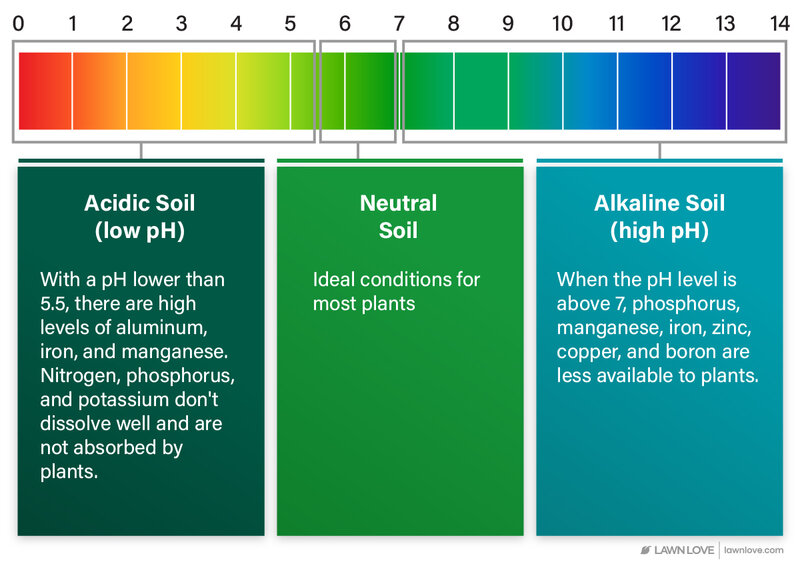
Just knowing if your soil comprises sand or clay isn’t enough. You also need to know if it’s acidic or alkaline (or somewhere in between), which is what the pH level will tell you.
The pH is measured on a scale from 0 to 14; any number below 7 means the soil is acidic. Numbers above 7 mean the soil is alkaline. Having a number 7 represents that the soil is neutral.
Ideally, the pH of your soil should be between 6.0 and 7.0, which is slightly acidic. Most turfgrasses thrive in soils with a pH range between 6.0 to 7.0. If your pH is too high or too low, it could signal disease, nutrient deficiencies, or water retention problems.
- If your soil is too acidic (pH less than 7.0), you’ll most likely need to amend your soil with lime.
- If your soil is too alkaline (pH greater than 7.0), you’ll need to add sulfur as a soil amendment.
Understand your grass
Knowing the type of grass you have is crucial because it determines your care routine. Different types of grass need specific treatments at different times. For example, each grass type has a different growth cycle that determines watering and fertilizing.
There are two categories of grass types: warm-season grasses and cool-season grasses.
Warm-season grasses
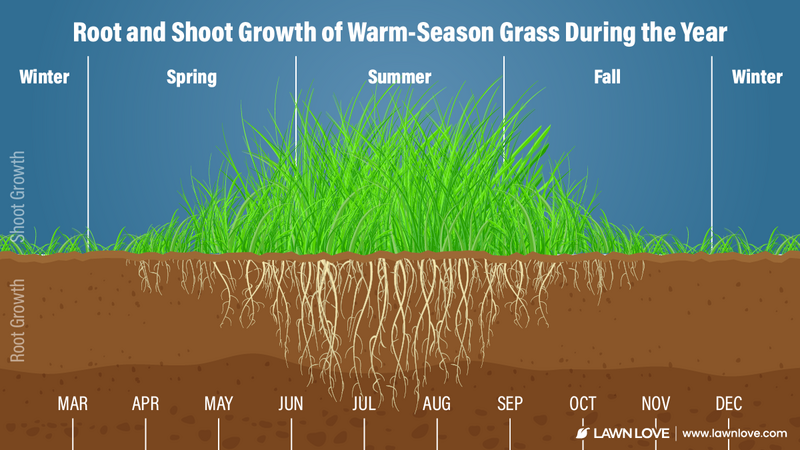
If you live in the Southern states, you probably have warm-season grass. These species thrive in hot weather, meaning they grow well in areas where the temperatures range between 75 to 95 degrees Fahrenheit during the growing season. Warm-season grass types include:
- Bahiagrass
- Bermudagrass
- Centipedegrass
- St. Augustine
- Zoysia
These cultivars don’t need to be watered as often as cool-season varieties, and they withstand drought better thanks to their deep root system and thick blades. Warm-season grasses grow during the summer and enter dormancy when temperatures fall below 65 degrees Fahrenheit.
Cool-season grasses

On the other hand, if you live in the Northern states, you probably have cool-season grass. Cool-season grasses grow well in areas where temperatures range between 50 to 75 degrees Fahrenheit. They include:
- Annual ryegrass
- Bentgrass
- Fine fescue
- Kentucky bluegrass
- Perennial ryegrass
- Tall fescue
Unlike warm-season grasses, cool-season grasses grow when temperatures are lower, such as in the spring and fall. In addition, they enter dormancy during the summer (or when the winter is too chilly).
Water your lawn

Water is an essential resource for all living things, but it’s not easy to track when and how much to give your lawn. The first step towards cultivating a beautiful lawn is proper watering practices. Follow a few simple tips to get the most out of your watering routine:
- Location: The amount of water a lawn needs depends on where you live and the time of year. If you live in an area with a lot of rain and mild weather, you won’t need to irrigate as much as someone living in a desert or somewhere with scorching summers.
- Amount: Water 1 to 1.5 inches per week. This amount can be reduced by half or more in cooler climates or when rainfall is higher than usual. Be careful not to overwater or underwater your lawn.
- Time of the day: Water between 6 a.m. and 10 a.m. to ensure that the water doesn’t evaporate before it hits its target. Also, avoid watering during peak sun hours (between 10 a.m. and 4 p.m.) and at night (this can promote an environment for mold).
- How to water: Water your lawn thoroughly three times per week for 20 minutes each.
Pro tip: Investing in sprinklers can make your life easier and save time. You can use a timer to control when your sprinklers turn on and off, and sprinklers can be equipped with rain sensors that turn off the sprinklers when it rains so your lawn doesn’t get oversaturated.
Mow at the right height

Lawn mowing is a fundamental part of lawn care. It’s a simple process, but it can also be tricky. The last thing you want to do is damage your grass by mowing your lawn at the wrong height.
When your grass is too tall, it becomes an ideal environment for pests and fungi to multiply. In addition, if you let your grass grow too much, the long clippings won’t decompose and may damage your lawn, preventing it from absorbing enough water and nutrients.
When it’s too short, it won’t be able to photosynthesize properly, which can hinder root growth and make it vulnerable to pests and disease.
Pro tip: A good rule of thumb is never to cut more than one-third of your grass’s height in a single mow and sharpen your mower blades annually to reduce tearing.
Mowing your grass too low is known as scalping, and while it may be a good idea in certain instances, in general, you should avoid scalping your lawn, as it stresses and weakens your turfgrass.
Here’s a chart of the recommended mowing heights for each grass type:
| Grass Type | Optimal Mowing Height |
| Bahiagrass | 2-3 inches |
| Bentgrass | 0.25-1 inches |
| Bermudagrass | 0.5-1.5 inches |
| Buffalograss | 1.5-3 inches |
| Centipedegrass | 1-2 inches |
| Fine Fescue | 1.5-2.5 inches |
| Kentucky Bluegrass | 1.5-2.5 inches |
| Perennial Ryegrass | 1.5-2.5 inches |
| St. Augustinegrass | 2.5-4 inches |
| Tall Fescue | 2-3.5 inches |
| Zoysiagrass | 0.5-2 inches |
Remember that grass grows at different rates depending on the season and the species. Warm-season grasses need to be mowed more frequently during the summer while cool-season grasses require more upkeep during the spring and fall.
Fertilize your lawn

If you want the grass to be greener on your side, you need to give it the right vitamins every once in a while. Just like people, different lawns need different types of vitamins. A laboratory soil test will tell you what proportion of these elements you should feed your lawn. Turfgrass requires three primary nutrients:
- Nitrogen (N) supports leafy growth and vibrant green color.
- Phosphorus (P) aids in root development.
- Potassium (K) contributes to disease resistance and overall stress tolerance.
There are two common ways you can apply fertilizer to your lawn:
- Liquid fertilizer is easier to apply and more easily absorbed by plants. However, it’s more expensive and may require you to apply it more often. Apply it with a sprayer or connect the bottle to your hose.
- Granular fertilizer provides nutrients for longer, and it’s cheaper, but it can be challenging to apply homogeneously. It doesn’t act fast enough if your lawn is in immediate need. It can be used with different types of spreaders.
Timing is everything when it comes to fertilizing your yard, and the best time of year to apply fertilizer differs between warm-season and cool-season grasses:
- For cool-season grasses, fall and spring are the best times to fertilize.
- For warm-season grasses, mid-spring through summer is the best time to fertilize.
Warning: Excess fertilizer can damage your lawn, causing iron chlorosis and even root rot. So be careful and read the instructions on the label.
Pro tip: When you are searching for a good fertilizer, look for an N-P-K ratio that suits your lawn’s needs. As an example, a fertilizer that is labeled as 25-10-15 has a ratio of 25% nitrogen, 10% phosphorous, and 15% potassium.
Control weeds
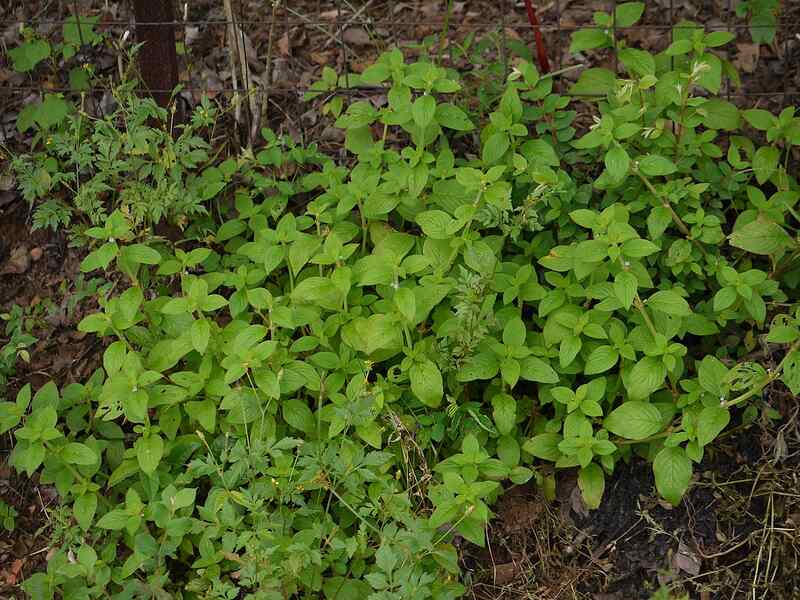
Dinesh Valke | Wikimedia Commons | CC BY-SA 2.0
Weeds are the bane of any homeowner’s existence. They grow anywhere and everywhere, and they’ll ruin your lawn by competing with your grass for nutrients and space if you don’t take care of them.
Lawns usually contain three types of weeds:
- Broadleaf weeds have wide, veiny leaves that are flat. Examples include dandelions, clover, and chickweed.
- Grassy weeds have long, narrow leaves with parallel veins, such as crabgrass or foxtail.
- Grass-like weeds look a lot like grasses due to their long and thin leaves, but they usually grow faster and have different colorations. Examples include sedges and wild onions.
Hand-pulling is an effective but tedious option for weed control, and digging weeds up by hand won’t be feasible if the weed infestation is too large, so you will have to turn to alternative solutions instead.
If you are tired of pulling weeds out by hand, herbicides are an effective way to kill weeds:
- Pre-emergent herbicides prevent weed seeds from germinating
- Post-emergent herbicides target weeds that are already growing.
However, some homeowners don’t want to use chemical weed killers, so there are some natural remedies for getting rid of weeds that you can try, such as a homemade vinegar spray or pouring boiling water on weeds.
You can also prevent weeds from appearing without using synthetic chemicals by following these tips:
- Leave grass clippings to create a mulch layer that blocks weed seeds from the sun.
- Spread corn gluten meal in your yard, which can work as a pre-emergent herbicide.
- Water deeply so your grass roots grow deeper, and there’s less space for weed roots.
Pro tip: It’s important to check if the herbicide you’re buying targets the lawn weed you’re trying to get rid of and if they are selective or nonselective.
Rake leaves
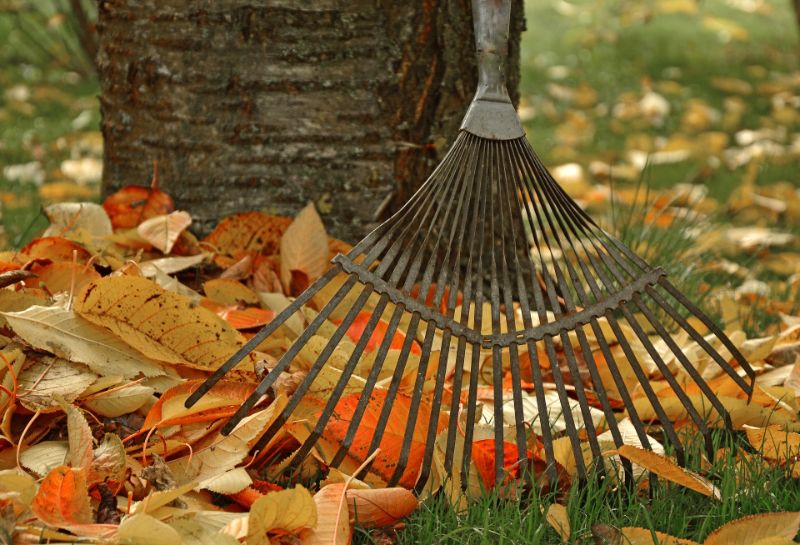
Raking leaves is probably the most tedious part of lawn care, but it’s essential. There are few things worse than a thick mat of moldy leaves on your lawn–it can invite pests and diseases and make grass struggle to photosynthesize.
Luckily, there are ways to make raking easier. Here are some tips for removing leaves from your yard:
- Divide your property into sections and rake one area at a time.
- Rake with the wind to have gravity on your side.
- Get a leaf blower or a leaf blower vacuum (you’ll thank us later).
- Rake the leaves onto a tarp, so you don’t have to bend over every few minutes.
If, despite these tips, you still can’t rake all the leaves on your lawn, there’s no problem with that. You can stomp on the piles of leaves so they don’t blow away and continue your job the next day. You can also hire a professional and save yourself time and possible back pain.
Dethatch your lawn

Over time, dead grass and other organic matter, called thatch, gets trapped at the base of grass blades. Dethatching your yard removes that thick layer of organic matter. Removing thatch allows water and nutrients to reach deeper into your soil, encouraging healthier growth.
Dethatching helps prevent disease and pests from taking hold in your grass, which means you’ll spend less time on maintenance. However, a layer of thatch less than ½ inch is beneficial to your lawn and can act as organic mulch, but once it gets too thick, it can be detrimental.
Dethatching is usually done once a year:
- For cool-season grasses, dethatch your lawn in the early spring or early fall.
- For warm-season grasses, dethatch in the late spring or early summer.
Some grass species are more prone to thatch, such as Kentucky bluegrass and Bermudagrass. Still, tall fescues and perennial ryegrasses usually don’t have thatch problems.
Pro tip: Always check the height of your thatch layer before dethatching. If the layer is more than half an inch, it’s time to dethatch. You can buy a dethatcher online or rent it at a local home improvement store.
Aerate your soil
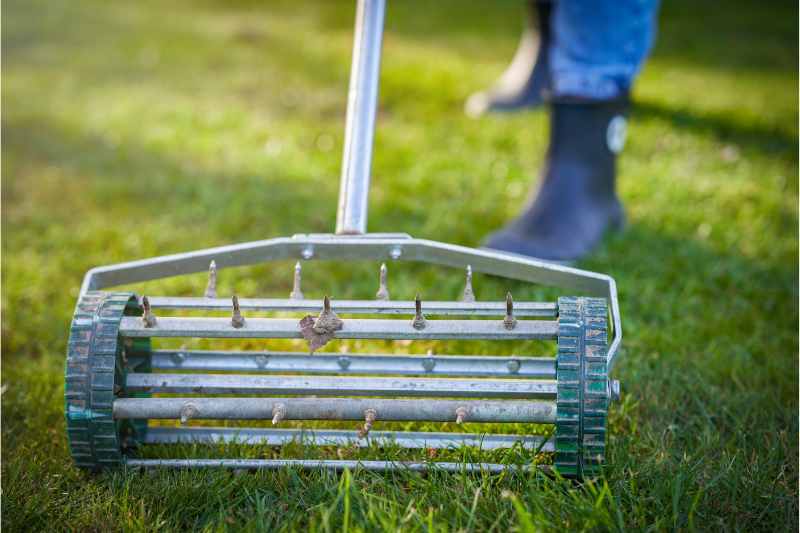
Aeration is the process of removing small plugs of soil from your lawn so the soil is less compacted and oxygen, water, and nutrients can flow into it. It might look like you’re ruining your lawn at first, but aeration is incredibly beneficial for its health.
Professional lawn aeration typically costs $75 to $225, depending on the size of your yard and the aeration method used, and the best time to aerate your lawn depends on your grass type.
- Cool-season grasses should be aerated in the early spring or early fall
- Warm-season grasses should be aerated in the late spring through early summer.
Pro tip: You can test if your soil needs aeration by doing the screwdriver test:
- Take a screwdriver and push it into your lawn.
- If the screwdriver penetrates the soil with ease, your soil isn’t compacted and doesn’t need aeration.
- If it takes more force than usual to push the screwdriver in (or about 6 inches), your soil is probably compacted and needs aeration.
Cover bare spots
Are you tired of having bald patches on your lawn? If so, there’s a solution. Overseeding creates thick turf and prevents bare spots. It is the process of adding new grass seed to an existing lawn.
Overseeding is a great way to get your grass back up and running after a bad year or fix patchy lawn spots that are just not growing well. Even after bald patches have developed, overseeding helps treat them.
Overseed once a year after mowing, dethatching, or aerating so the seeds reach the soil to germinate and take root. Don’t forget to water the area daily for at least a week. The best way to spread grass around your yard is to use a seed spreader.
As for the best time of year to overseed your grass:
- Overseed warm-season lawns in the late spring or early summer.
- Overseed cool-season lawns are in the early spring or early fall.
An alternative to overseeding is sod installation. Sod will give you an instant lawn without the wait. While sod can be installed in your yard any time of the year so long as the ground isn’t frozen, there are optimal times of year to install sod depending on your turfgrass:
- Install warm-season grass sod in the mid or late spring.
- Install cool-season grass sod in the early fall or spring.
It takes a couple of weeks for the sod to settle in and get used to its new home, so it will need a lot of water while the grass integrates into your lawn. Don’t walk on the sod until at least 2 weeks after installation.
The downsides of sod installation are that it’s more expensive than grass seed and it’s a labor-intensive DIY project. Spreading new grass seed around your yard is an easier task for a beginner than installing sod.
Control pests
Uh oh, have insects invaded your lawn? The first thing to know is that not all bugs are pests–some are necessary for the lawn’s health and the environment. So before you start spraying pesticides, check that they are not ladybugs, honeybees, butterflies, or other beneficial insects.
Pay attention to signs of pests on your lawn:
- Wilted grass blades
- Discoloration
- “Skeletonized” leaves
- Burrows
- Signs of digging
- Larger bird presence
If you don’t want to deal with the creepy crawlies yourself and you’d rather let a pro handle all the pesticide applications, you can hire professional pest control services.
Contain lawn diseases

Lawn diseases are a common problem for many homeowners, and they can be frustrating to deal with. Most lawn diseases are caused by fungi. Here’s how to identify a fungal problem:
- Yellowing grass blades
- Brown patches
- Dry areas that don’t recover after watering
- Discolored patches of grass that are surrounded by healthy-looking grass
The best way to combat a lawn disease is to practice good lawn care. In most cases, mowing the lawn, aerating the soil, and removing plant debris help contain lawn diseases.
But if a lawn disease returns year after year despite good lawn care practices, chemical fungicides may prove helpful as a last resort.
FAQs about lawn care
Can you put too much grass seed on your lawn?
Yes. If you spread too much grass seed on your lawn, it will make the grass compete against each other for nutrients. Ultimately, this will damage the health of your lawn. It is important to use a seed spreader to get an even distribution of seeds across your lawn. Aim to seed about 15 to 20 grass seeds per square inch of lawn.
How long does it take grass seed to germinate?
Different grass types have different germination time frames, but you can expect grass to germinate in a week or up to a month. Make sure to regularly water and keep the soil moist while you are waiting for grass seeds to grow.
Should you fertilize or overseed first?
What to do first depends on the condition of your lawn. You should fertilize a healthy, lush lawn first to give it a boost before you overseed. If a lawn is thin and not robust, it’s better to overseed it first before adding fertilizer.
Call a lawn care pro
We hope this article has helped you break down your lawn care barriers so that you won’t be intimidated by lawn maintenance. However, all this information can be overwhelming, especially if you are still “green” regarding lawn care.
For that, there is no shame in hiring lawn care services and getting a professional to come to your aid, especially for the most tedious jobs, such as aerating and weeding.
Main Image Credit: Pexels